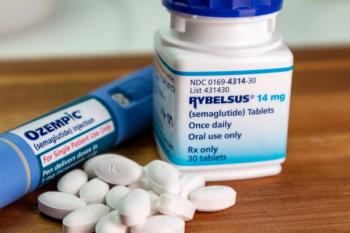
The Challenge of Psychogenic Nonepileptic Seizures
Affected patients with intractable epilepsy are treated, often for years, with antiepileptic drugs and other interventions that can promote further morbidity.
Is it epilepsy or conversion disorder? An estimated 5% to 10% of outpatients receiving treatment for epilepsy and about 20% to 40% of patients hospitalized for intractable epilepsy may be suffering from another condition: psychogenic nonepileptic seizures (PNES).1,2 The psychiatric community defines it as a conversion disorder, and experts in the field--both neurologists and psychiatrists--emphasize that it is, indeed, a real and debilitating condition but that it is a somatoform disorder, not epilepsy.
As recognition of the disorder grows and more research emerges, guides for distinguishing PNES from epilepsy, as well as management strategies, are becoming available. Video-electroencephalographic (V-EEG) monitoring and observation of seizure activity specific to PNES are important in arriving at a differential diagnosis--considering that the health care burden associated with misdiagnosis of PNES, although unstudied as yet, is conjectured to be quite high. In their introduction to a report on a health care utilization study, a team led by Roy C. Martin, PhD, director of neuropsychology services for the UAB Comprehensive Epilepsy Program at the University of Alabama at Birmingham, estimated the figure to be $110 million to $920 million per year, calculated under the assumption that 300,000 to 400,000 people are affected and are being treated for at a lifetime cost of $100,000 per patient.3
Affected patients are treated, often for years, with antiepileptic drugs (AEDs) and other interventions that can promote further morbidity,4-6 and one study demonstrated that morbidity persists years after an appropriate diagnosis is made.6 Seventy-one percent of 164 patients who responded to a series of outcome, personality, and psychosymptomatic questionnaires about 4 years after PNES was diagnosed reported that they continued to have seizures. Fifty-six percent of respondents reported that they were unemployed or had retired because of their disability. Furthermore, 40.7% of respondents continued to receive AEDs after a PNES diagnosis was made--and 82% were readmitted to neurology wards.
"What accounts for the breakdown between diagnosis and implementation of treatment?" questioned Andres M. Kanner, MD, associate professor of neurological sciences and psychiatry at Rush Medical College in Chicago, in a commentary on the study.7 In his outline of possible explanations, Kanner cited a lack of communication between neurologists and psychiatrists and referred to a study he coauthored, showing that fewer than 20% of psychiatrists believed V-EEG findings were reliable in diagnosing PNES.8
Kanner concluded that a collaboration must be forged between the treating neurologist, mental health practitioner, patient, and patient's family so that the psychogenic features of the disability are addressed and the neurologic features are monitored. "Such collaboration may help patients achieve a safer and complete discontinuation of AEDs," he wrote.
Among neurologists, V-EEG findings are considered to be diagnostically definitive for PNES. Martin and colleagues also found that routine V-EEG monitoring for the differential diagnosis of epilepsy can significantly reduce health care utilization and its attendant costs.3 The study, published in Seizure in 1998, compared health care utilization for 20 patients 6 months before and 6 months after a V-EEG-confirmed diagnosis of PNES. At 6 months postdiagnosis, total seizure-related medical charges were reduced by an average of 84%. A 97% reduction in emergency room visits and an 80% reduction in outpatient visits were achieved. Furthermore, an average 76% reduction in diagnostic testing charges and a 69% reduction in medication charges were seen.
The study authors pointed out that patients in whom PNES had been diagnosed received consultations about their diagnosis from the attending physician and the epilepsy care team and from a clinical psychologist. The patients also received assistance in obtaining referrals for outpatient mental health care.
Although V-EEG monitoring has become the preferred diagnostic tool, clinical researchers also are recognizing symptomatic signs that distinguish PNES from epilepsy. Markus Reuber, MD, PhD, MRCP, consultant neurologist at the University of Sheffield in England, and Christian Elger, MD, FRCP, director of the Department of Epileptology at the University of Bonn Medical Center in Germany, compiled a list of distinguishing symptomatic features in a comprehensive literature review about PNES.4 They note that gradual onset, undulating and asynchronous movements, closed eyelids, resistance to lid opening, prolonged convulsive episodes (more than 2 minutes), lack of cyanosis, and rapid postictal reorientation are common in PNES but rare in epileptic seizures.
Patients with PNES also tend to have distinguishing historical features that epileptic patients rarely share. Features listed by Reuber and Elger include recurrent status seizures, multiple unexplained physical symptoms, multiple operations and invasive tests, psychiatric intervention, and sexual and physical abuse.4 A history of chronic pain or fibromyalgia also is common among patients with PNES, according to a recent study9 by Selim R. Benbadis, MD, director of the Comprehensive Epilepsy Program and associate professor of neurology in the departments of neurology and neurosurgery at the University of South Florida in Tampa.
In addition, commentators point out that patients with PNES are typically challenged with a host of mental health issues.3-5,10-13 Childhood abuse and stress-related disorders4,10-13 have often been noted to be associated with PNES. Early intervention and the ability of patients and their families to accept and seek appropriate care for PNES are crucial.4,13-17 Studies show that morbidity is high among patients who fail to accept the diagnosis.6,17
APPROPRIATE INTERVENTION
Once the diagnosis of PNES has been established, what's next for the patient? Taoufik Alsaadi, MD, assistant professor of clinical neurology, and Anna Vinter Marquez, MD, a resident in psychiatry at the University of California at Davis, instruct clinicians to identify and address the specific psychopathology. In a comprehensive literature review published this past September in American Family Physician,10 they outline psychotherapeutic protocols that have been recommended in the literature to treat the underlying causes of PNES.
The authors note that no randomized controlled studies have been conducted on the management of PNES but that evidence18,19 suggests that psychotherapeutic intervention is of value. The manner in which diagnosis is disclosed appears to be important as well. Benbadis writes in a review posted on eMedicine (www.emedicine.com/NEURO/topic403.htm), "[t]he main obstacle to effective treatment is effective delivery of the diagnosis."13
According to Benbadis, obstacles include the examining physician's uneasiness about a PNES diagnosis and lack of communication about the diagnosis with the referring physician, as well as physician awkwardness about discussing the diagnosis with the patient. Like Kanner, he asserted that psychotherapeutic intervention is imperative and that an ongoing team approach must be forged by the neurologist and the mental health provider.
In a recent study15 that evaluated outcomes related to a specific protocol for disclosing diagnosis of PNES, 86% of patients surveyed 2 years after PNES was diagnosed reported that the intensity and/or frequency of their seizures was reduced.
The aim of the protocol, adapted from a protocol by Shen and colleagues and published in Neurology in 1990,20 was to "reframe" the diagnosis in a sensitive, honest, and acceptable manner. The patient is reassured that her seizures are nonepileptic and not associated with brain damage. Terms such as "psychogenic" and "pseudoepileptic" are not used, and during the history taking, the patient is not asked directly whether she has experienced sexual abuse, but whether she has ever undergone "traumatic or stressful life events."
The patient is informed that the exact cause of the seizure is unknown but is probably due to too much "psychological energy" and emotional stress. It is explained that AEDs will not help her condition and that the staff will assist in helping the patient discontinue them. While emphasizing the good news that she does not have epilepsy or brain damage but that her condition is real and treatable, the staff informs the patient that others with her condition have been helped by psychotherapeutic intervention. She is given patient education literature about PNES and reassured that the seizures may improve over time as she accepts her diagnosis and seeks appropriate intervention for emotional stressors.
Finally, Benbadis in his eMedicine review13 noted that written patient education resources about PNES are important, although scarce. Fortunately, he has been particularly proactive in physician and patient education about PNES and has coauthored a guide for patients and families titled Psychogenic (Non-Epileptic) Seizures: A Guide for Patients & Families that is available on the Web at http://hsc.usf.edu/COM/epilepsy/ PNESbrochure.pdf. *
For references, please go to www.appneurology.com.
References:
1. Gates JR. Epidemiology and classification of non-epileptic events. In: Gates JR, Rowan AJ, eds. Non-Epileptic Seizures. 2nd ed. Boston: Butterworth-Heinemann; 2000:3-14.
2. Benbadis SR, Agrawal V, Tatum WO 4th. How many patients with psychogenic non-epileptic seizures also have epilepsy? Neurology. 2001;57:915-917.
3. Martin RC, Gilliam FG, Kilgore M, et al. Improved health care resource utilization following video-EEG-confirmed diagnosis of nonepileptic psychogenic seizures. Seizure. 1998;7:385-390.
4. Reuber M, Elger CE. Psychogenic nonepileptic seizures: review and update. Epilepsy Behav. 2003;4:205-216.
5. Francis P, Baker GA. Non-epileptic attack disorder (NEAD): a comprehensive review. Seizure. 1999;8:53-61.
6. Reuber M, Pukrop R, Bauer J, et al. Outcome in psychogenic nonepileptic seizures: 1- to 10-year follow-up in 164 patients. Ann Neurol. 2003;53:305-311.
7. Kanner AM. Psychogenic nonepileptic seizures are bad for your health. Epilepsy Curr. 2003;3:181-182.
8. Harden CL, Burgut FT, Kanner AM. The diagnostic significance of video-EEG monitoring findings on pseudoseizure patients differ between neurologists and psychiatrists. Epilepsia. 2003;44:453-456.
9. Benbadis SR. A spell in the epilepsy clinic and a history of "chronic pain" or "fibromyalgia" independently predicts a diagnosis of psychogenic seizures. Epilepsy Behav. 2005;6:264-265.
10. Alsaadi TM, Marquez AV. Psychogenic nonepileptic seizures. Am Fam Physician. 2005;72:849-856.
11. Dikel TN, Fennell EB, Gilmore RL. Posttraumatic stress disorder, dissociation, and sexual abuse history in epileptic and nonepileptic seizure patients. Epilepsy Behav. 2003;4:644-650.
12. Frances PL, Baker GA, Appleton PL. Stress and avoidance in pseudoseizures: testing the assumptions. Epilepsy Res. 1999;34:241-249.
13. Benbadis SR. Psychogenic nonepileptic seizures. eMedicine. Available at: www.emedicine.com/NEURO/topic403.htm. Accessed October 19, 2005.
14. Rosenberg HJ, Rosenberg SD, Williamson PD, Wolford GL 2nd. A comparative study of trauma and posttraumatic stress disorder prevalence in epilepsy patients and psychogenic nonepileptic seizure patients. Epilepsia. 2000;41:447-452.
15. Thompson NC, Osorio I, Hunter EE. Nonepileptic seizures: reframing the diagnosis. Perspect Psychiatr Care. 2005;41:71-78.
16. Quigg M, Armstrong RF, Farace E, Fountain NB. Quality of life outcome is associated with cessation rather than reduction of psychogenic nonepileptic seizures. Epilepsy Behav. 2002;3:455-459.
17. Ettinger AB, Devinsky O, Weisbrot DM, et al. A comprehensive profile of clinical, psychiatric, and psychosocial characteristics of patients with psychogenic nonepileptic seizures. Epilepsia. 1999;40:1292-1298.
18. Lesser RP. Psychogenic seizures. Neurology. 1996;46:1499-1507.
19. Aboukasm M, Mahr G, Gahry BR, et al. Retrospective analysis of the effects of psychotherapeutic interventions on outcomes of psychogenic nonepileptic seizures. Epilepsia. 1998;39:470-473.
20. Shen W, Bowman ES, Markand ON. Presenting the diagnosis of pseudoseizure. Neurology. 1990;40:756-759.
Newsletter
Receive trusted psychiatric news, expert analysis, and clinical insights — subscribe today to support your practice and your patients.















